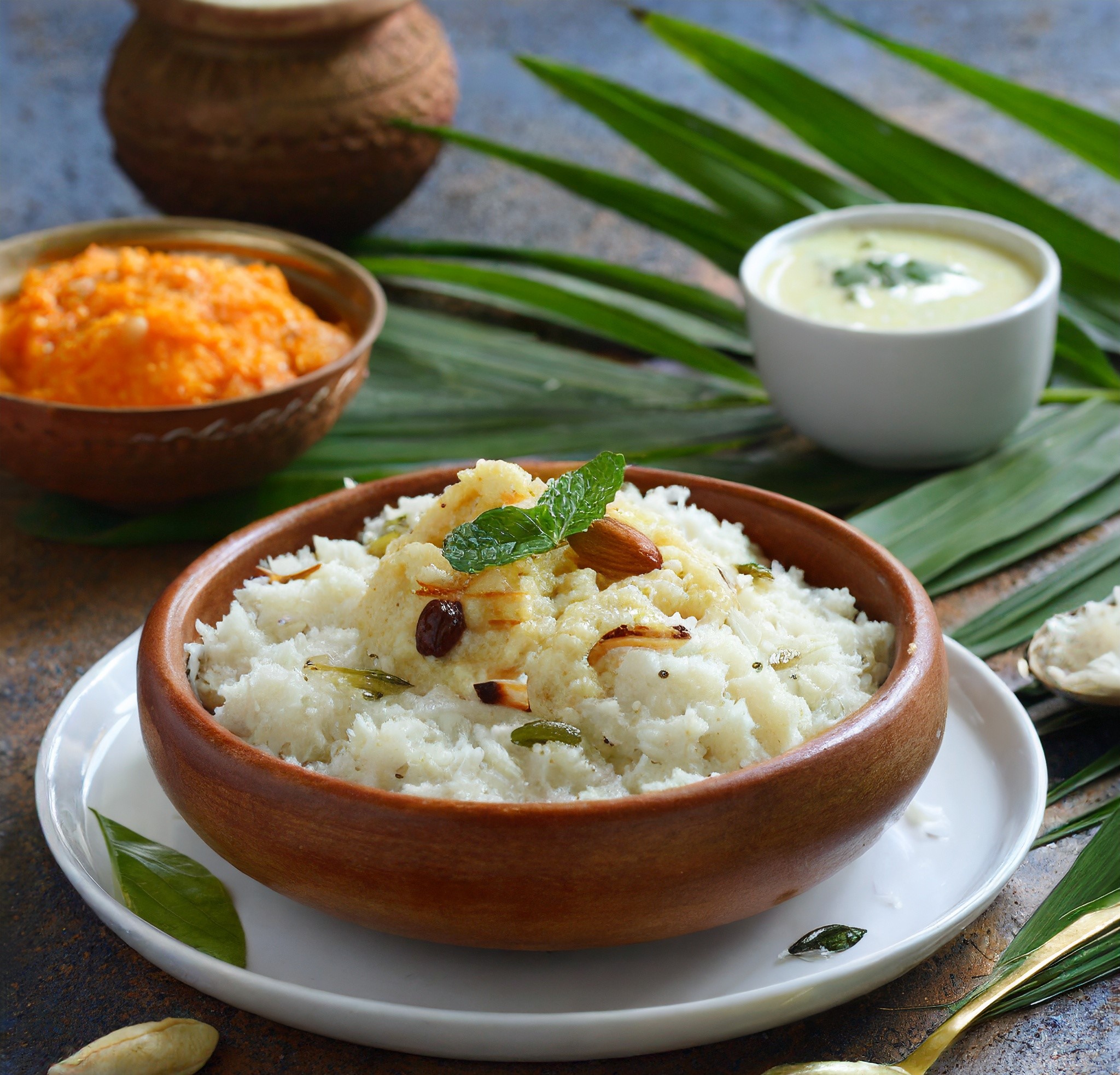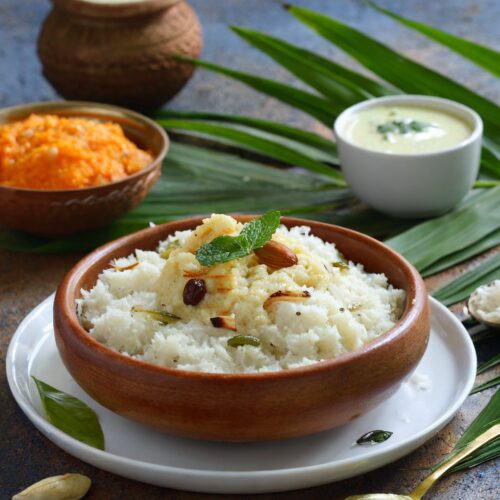Pongal Food Recipes | Flavors of South India

Introduction to Pongal Food Recipes
Welcome to the world of Pongal food recipes! Pongal, a popular harvest festival celebrated in South India, is not just about traditions and festivities; it also offers a wide array of delicious and wholesome dishes. In this article, we will explore the culinary delights of Pongal and dive into various traditional and innovative recipes that you can try at home. From the classic Ven Pongal to delectable variations, healthy twists, and regional specialties, get ready to tantalize your taste buds with the flavors of Pongal. So, let’s embark on this gastronomic journey and discover the joy of cooking and relishing Pongal food recipes!
1. The Significance of Pongal Festival
Pongal Festival is a time to honor the sun god and celebrate the abundance of the harvest season. It holds great importance in the Tamil culture and is observed with great enthusiasm. The festival is named after the dish “Pongal,” which is prepared using newly harvested rice and lentils, symbolizing prosperity and good fortune. It is a time for family gatherings, traditional rituals, and of course, indulging in scrumptious food.
2. Exploring the Culinary Delights of Pongal
Pongal is not just about one particular dish; it encompasses a wide variety of flavors and recipes. From the savory and comforting Ven Pongal, also known as Khara Pongal, to the sweet and aromatic Sakkarai Pongal, there is something to satisfy every palate. Additionally, Pongal is also known for its unique variations, incorporating ingredients like millets, vegetables, and even quinoa, giving a modern twist to the traditional recipes.

Pongal Food Recipe
Ingredients
Pongal Recipe
- 1 cup raw rice
- 1 cup split yellow moong dal (lentils)
- 1/4 cup ghee (clarified butter)
- 1/2 tbsp cumin seeds
- 1/2 tbsp black pepper
- A pinch of Asafoetida (Hing)
- 10/12 cashews
- A few curry leaves
- 2-3 green chilies (adjust to taste)
- 1 inch piece of ginger, finely chopped
- Salt to taste
- 4 cups water
Coconut Chutney Recipe
- 1 cup fresh coconut, grated
- 2-3 green chilies (adjust to taste)
- A small piece of ginger
- 1/2 cup roasted chana dal (split gram)
- 1/4 cup curd (yogurt)
- Salt to taste
- 2 tbsp oil
- 1/2 tbsp mustard seeds
- A few curry leaves
- 1 dry red chili (optional)
Instructions
Pongal
- Start by dry-roasting the moong dal in a pan until it turns golden and releases a nutty aroma. Keep it aside.
- In a heavy-bottomed pan, wash the rice and add the roasted moong dal. Add 4 cups of water and a pinch of salt. Cook this mixture on medium heat until it's soft and mushy. You can also use a pressure cooker for quicker results.
- In a separate pan, heat ghee and add cumin seeds, black pepper, and asafoetida. Sauté until the cumin seeds start to splutter.
- Add cashews, green chilies, and ginger to the pan. Sauté until the cashews turn golden brown.
- Add curry leaves to the pan and give it a quick stir.
- Pour this ghee and spice mixture into the cooked rice and lentil mixture. Mix everything well.
- Adjust the salt and consistency according to your preference. If you like it thinner, add some hot water.
- Serve your delicious Pongal hot, garnished with more ghee and freshly ground black pepper.
Coconut Chutney
- In a blender, add grated coconut, green chilies, ginger, roasted chana dal, curd, and salt.
- Blend everything into a smooth paste. You may need to add a little water to get the desired consistency.
- In a separate pan, heat oil and add mustard seeds. Let them splutter.
- Add curry leaves and the dry red chili (if using) to the pan. Sauté for a few seconds.
- Pour this seasoned oil mixture over the coconut chutney and mix well.
- Your Coconut Chutney is ready to be served alongside Pongal.
Special Pongal Dishes from Different Regions
Pongal celebrations vary across different regions of South India, and so does the culinary tradition. Here are some special Pongal dishes from different states:
1. Chakkara Pongal from Tamil Nadu
Chakkara Pongal, also known as Sweet Pongal, is a classic Tamil Nadu delicacy prepared during Pongal. Made with rice, moong dal, jaggery, and garnished with ghee and cashews, it is a sweet treat that will leave you craving for more.
2. Huggi Pongal from Karnataka
Huggi Pongal, a popular dish in Karnataka, is a unique blend of rice, lentils, and coconut. The addition of ghee, spices, and cashews gives it a distinct flavor that sets it apart from other Pongal recipes.
3. Pongali from Andhra Pradesh
Pongali, also known as Khichdi, is a traditional Andhra Pradesh dish prepared during Pongal. It is made with rice, moong dal, and seasoned with spices like cumin seeds, ginger, and black pepper. The simplicity of this dish allows the flavors to shine through.
With so many delightful Pongal recipes to choose from, this harvest festival is truly a food lover’s paradise. Whether you stick to the traditional recipes or venture into new variations, Pongal is a time to indulge in the rich culinary heritage of South India. So, gather your loved ones, put on your apron, and let the flavors of Pongal take you on a delightful gastronomic journey.
Conclusion and Final Thoughts on Pongal Food Recipes
Pongal is not just a dish; it’s a celebration of flavors, traditions, and togetherness. With these recipes and tips in hand, you’re all set to create a memorable Pongal feast. Whether you choose to stick to the traditional recipe or experiment with healthier and gluten-free alternatives, Pongal is a versatile dish that never fails to please the taste buds. So, gather your loved ones, embrace the warmth of Pongal, and create a feast that will be cherished for years to come. Happy Pongal!
FAQ
1. What food is eaten during Pongal?
During the Pongal festival, a traditional South Indian dish called “Pongal” is the primary food that is eaten. Pongal is a savory dish made with rice and lentils, typically seasoned with black pepper, cumin seeds, ghee (clarified butter), and other spices. It is often served with a side dish like coconut chutney and is a central part of the Pongal celebration.
2. What special dishes are prepared on Pongal?
The most special dish prepared during Pongal is, of course, Pongal itself. In addition to the classic Pongal, other special dishes may include sweet Pongal (Sakkarai Pongal), which is a sweet rice and lentil dish cooked with jaggery and flavored with cardamom and cashews. Coconut chutney and various South Indian vegetable curries are also commonly prepared to accompany the Pongal.
3. Which Dal is Pongal made of?
Pongal is traditionally made with split yellow moong dal (lentils). This lentil variety is known for its quick cooking time and a smooth, creamy texture it imparts to the dish when cooked.
4. Which rice is best for Pongal?
The best rice for making Pongal is typically a short-grain variety. In South India, it’s common to use a specific type of rice called “ponni rice” or “Sona Masoori rice” for making Pongal. These rice varieties have a soft, fluffy texture when cooked, making them perfect for this dish. However, you can use other short-grain or medium-grain rice varieties if you don’t have access to these specific types.
